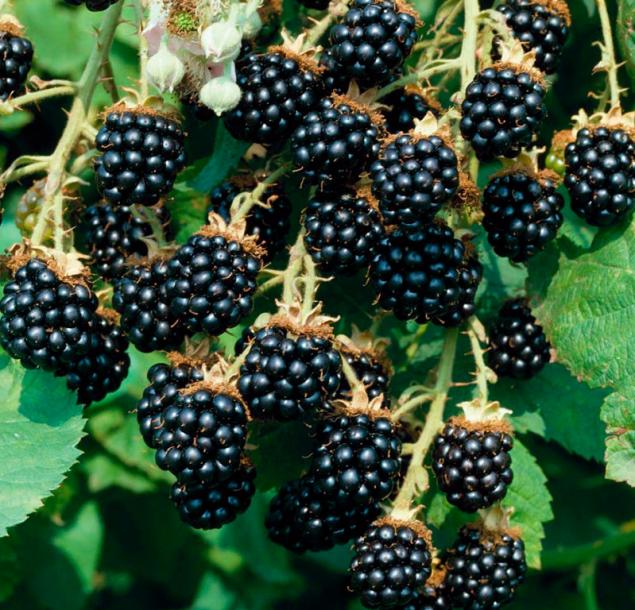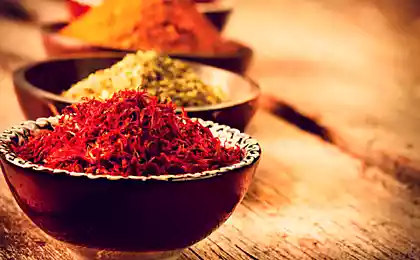1468
42 wild plants that can be eaten

We all know which fruits and vegetables safe to eat, but what about the other wild vegetation?
Here are some common useful plants that are safe to eat, if you find yourself a long time in the wild:
Blackberry
Many wild berries unsafe to eat better and stay away from them. But wild blackberries on a 100% safe and it is easy to recognize. It has red branches, which are located on the long spikes as a rose, green leaves, broad and toothed. The easiest way to find blackberries in the spring, when the bloom of its white flowers. It grows around the bushes, and its flowers have five petals. The berries ripen in August, about -. September
Dandelions
The easiest way to recognize the dandelions in the spring when they show their bright yellow buds. You can eat them raw or boiled to remove bitterness. Usually less bitter they are in the spring. Dandelions are rich in vitamins A and C, and beta-carotene. In addition, there are other edible flowers.
Asparagus
This vegetable grows in the wild in most of Europe and parts of North Africa, Western Asia and North America. Wild asparagus has a much thinner stem than its kind in the grocery store. It - an excellent source of vitamin C, thiamine, potassium and vitamin B6. Eat asparagus raw or boil, as if you prepared it at home.
Elderberries
Elderberry shrub can reach three meters in height and produce a large number of berries. The structure of the sheet is usually as follows: 7 main leaves on a long extended stem; leaves elongated and rounded, have jagged edges.
Elderberry easiest to recognize in the spring, when it bloom clusters of white flowers that resemble umbrellas. Remember this place. Berries ripen around September.
Elderberry is known for its healing properties in the fight against colds and flu. You can make jelly out of it - it gives a very sweet and delicious
. Gooseberries
He is gray branches with long red thorns and bright five-pointed green leaves, similar in shape to the maple leaf, but with rounded edges. The flowers appear in spring and are unusual, berries ripen somewhere in late May early June.
Mulberry (mulberry)
Mulberry leaves are of two types: kopeobraznye and five-pointed. And those and others have pointy edges.
Pine
There are over a hundred different species of pine. It can be used not only as food but also for medical purposes. Skipyatite water and add a few needles to make tea. Previously, pine needles, rich in vitamin C, used to treat scurvy.
Daylily
You can find this plant in many parts of the country, it has bright orange flowers and foliage that grows out of the ground, without the stem. You can eat the flower bud before it bloom, just cook it like a vegetable.
Walnuts
Walnut trees the most recognizable and highest walnut tree, its height can vary from 9 to 40 meters. It has kopeobraznye leaves that grow on a long stalk of 6-8 on each side. green leaves with smooth edges. Usually walnuts grow in clusters and ripen in the autumn. On the Use and Abuse of the walnut is known today many interesting facts.
Acorns
Acorns is easy to learn. They tend to be bitter, and there should be boiled in a limited number.
Clover
Clover grows almost everywhere and is edible. If you see the grass, then most likely, it is a growing circle of clover - shamrock characteristic is easy to recognize. It can be eaten raw, but cooked it tastes better.
Red clover
The flowers can be eaten raw or brewed in hot water as a tea. And yet you can add and green leaves, and flowers in the salad.
Chicory
In the food can be consumed all the wild plant as a whole, along with the flowers.
Mother-and-stepmother
In the food can be consumed young leaves and flowers. The flowers can be eaten raw, and added to a salad, they give a wonderful fragrant shade. Take the flower heads and put them in a glass jar, add the honey and keep it for several weeks, until the honey hardens.
You can add a little honey with mother-and-stepmother in tea or use it as an excellent home remedy that helps to soothe the cough. The dried flower heads can be brewed as a tea or include recipes for cooking or baking.
Young leaves are bitter, but they can be boiled and added to salads, stews, or just flavor with lemon, olive oil and spices.
Glechoma hederacea
Young leaves can be eaten raw or cooked. They have a bland taste bitter and fragrant, ideal for salads. You can prepare these leaves like spinach or added to soups, stews, omelets. Fresh or dried leaves cooked tea. This wild plant is known that it is added to beer in the same manner as hops, transparency and for flavor.
Rogoz
Known as Schoenoplectus lacustris, cattail plant belongs to the genus usually grown near freshwater wetlands. Rogoz included in the diet of many Indian tribes. Most varieties of edible cattail. You can boil or eaten raw roots, or the plant itself.
Rootstock is usually underground. Make sure to carefully wash him. The best part of the stem is at the bottom, where the plant is mainly white. The stem can be boiled or eaten raw. Leaves boil as you would have done it with spinach.
In early summer the young flowering shoots of cattail can break off and have a corncob. Rogoz really like corn - the taste is the same
. Chesnochnik robur
Edible parts: flowers, leaves, roots and seeds. The leaves can be eaten at any time of the year, but when the weather gets hot, they get a bitter taste. The flowers can be crushed and added to salads. Roots can be harvested in the early spring and late autumn, when there is no flower stalks. Roots of pedunculate chesnochnika taste very sharp and a bit like hell. Yummy! are the seeds can be harvested in late autumn.
Chickweed
It usually appears in the May-July. Its leaves can be eaten raw or cooked -. They are rich in vitamins and minerals
Clover Field
Edible parts: flowers, leaves and seeds. The flowers are good to add to tea. In autumn you can collect the seeds and eat them immediately or pre-fry, as well as the ones you can make flour. Leaves added to salads, omelets, sandwiches, etc.
Robert Geranium
Edible parts: the whole plant. Fresh leaves can be added to salads or make them tea. The flowers, leaves and roots can be dried and stored to be used later as a tea or as a seasoning to enhance the flavor. Rubbing the skin fresh leaves are known to repel mosquitoes, and the plant itself will protect your garden from rabbits and deer.
Ligustikum Scottish
Use raw leaves in salads, sauces, in soups, rice or a mix with other herbs. Ligustikum has a strong flavor, and better to use it as a condiment as parsley, than have it without the whole. Taste ligustikuma better before flowering. It is sometimes called wild celery or parsley.
Plantain
This is another of those plants that grow right on the edge of the gardens and along the roads, but it is also edible. Choose green wavy leaves. Pour boiling water over them and fry with a little oil and garlic, just as you would do it with cabbage or any other hard greens.
Wild garlic
Wild garlic (Allium Vineale or wild garlic) - herbal delicacy is often found in fields, forests, pastures and loose soils. He reminds cultivated garlic or onions, but the shoots are usually very thin. Add it in sandwiches, salads, sauces, or decorate them as a main dish with green onions.
Watercress
Watercress (watercress salad, watercress, Arabis) has a spicy flavor and is ideal for salads, sandwiches and soups.
Pigweed white
Add raw leaves to salads or soups, mixed with other herbs, or add to any dish, preparation requires greenery. White pigweed susceptible to undermine the flies, so be careful: collect plants that are not infected. Pigweed white is better to eat before flowering, but if young fresh tops of going all the time, it is possible to have the whole summer.
Stevia
Edible parts: the whole plant, including the roots. The leaves and roots can be harvested in the summer, before flowering, they can dry up and stored until further use. Roots harvested in autumn. Fresh flowers are used for brewing herbal tea.
This weed was originally called "jo-share" - in honor of the legendary Indian healer who used a decoction of the plant for the treatment of fever in colonial America
. Local tribes used stevia purple as a healing tonic. It has been used to treat constipation, but strong tea from the root washed the wounds to prevent infection.
Amaranth
Edible parts: the whole plant - leaves, roots, stems and seeds. Amaranth seeds are small, very nutritious and easy to collect. Seed corn is used for the preparation of flour for baking. Roasting the seeds can enhance the flavor. You can also germinate the seeds and raw sprouts used in salads, sandwiches, etc. Young leaves can be eaten raw or cook them like spinach. Fresh or dried leaves of amaranth can be used for brewing tea.
Ivan-tea
This plant is found mainly in the northern hemisphere. You can recognize Ivan-tea in his pink flowers and the unique structure of the leaf veins - they are circular and do not end at the edges of the leaves. Some Indian tribes included in your diet Ivan-tea. It is best to have its young, when the leaves are tender and soft. In the adult plant leaves are tough and bitter to the taste. Stem plants are edible. The flowers and seeds have a pungent taste. Ivan tea - a great source of vitamins A and C.
Chernogolovka ordinary
Young leaves and stems can be eaten raw in salads, whole plant can be boiled, and have at other edible greens. The aerial parts of the plant can be ground into a powder and brewed from it a delicious drink. The plant contains vitamin A, C and K, as well as flavonoids and rutin. For therapeutic purposes, the whole plant is applied to a wound to promote healing. The infusion of this plant are used for rinsing the mouth for the treatment of sore throats, stomatitis and gum infections. From Chernogolovka tea helps in the treatment of diarrhea and internal bleeding.
Blindweed
Young leaves are added to salads raw, used in soups, mixed with other herbs in cooking or add to any dish where necessary herbs. While the leaves can be eaten throughout the summer, the adult plants they have a sharp taste that will not please every gourmet.
Prenebrezhёnny Mallow (Malva neglecta)
All parts of this plant are edible - the leaves, stems, flowers, seeds and roots (juice of the roots of his cousin Althea was used for the preparation of marshmallow)
. Since this is a weed that grows abundantly in abandoned areas, Mallow has been used throughout history as a product, due to which survive in times of crop failure or war.
Mallow has a high content of mucilage - a sticky substance that gives it a bit sticky structure similar to okra, perfectly suitable for soups. Mallow has a pleasant nutty flavor. One of the most popular ways to use mallow - as a green salad
. Oxyria digyna
Edible parts: flowers, leaves, roots. The leaves can be eaten raw or cooked. Fairly mild flavor with a sticky texture quite suitable for salad.
It is better to use the young leaves, older can be bitter, especially in the summer, and if the plant grows in hot and dry areas. Although the individual leaves are quite small, they grow in abundance, and they are easy to collect. The stems and flowers can be eaten raw. They are a nice addition to a salad. The fruit can also be eaten raw. Although the root is very small and it is difficult to produce, peeled and boiled it tastes like chestnut.
Thlaspi arvense
Thlaspi arvense - a weed that can be found in most countries of the world. The period of growth - from early spring to late winter. You can eat the seeds and leaves of Thlaspi raw or boiled. The only caveat: do not eat the plant, if it is growing in contaminated soil. Thlaspi is gipernakopitelem minerals - which means that it absorbs any substances and minerals are all around you. The basic rule: do not eat Thlaspi if it grows by the roadside or in a chemically contaminated area
. Night Violet
This plant is often mistaken for the phlox. Phlox has five petals and violets night only four. The flowers, which resemble phlox, are deep lavender, and sometimes pink or white. The plant is part of the cruciferous family, which also includes radish, broccoli, cabbage, cauliflower and mustard. The plant itself and its flowers are edible, but rather bitter. The flowers are attractive if they are added to green salads. Young leaves and germinated seeds can also be added to these salads (for culinary purposes leaves should be collected before flowering).
This is not one of the varieties of grasses, usually called rocket, which is used as greens for salads.
Wild Monarda (lemon balm)
From leaf brewed tea, using them as a seasoning, eaten raw or dried; flowers are edible too. Wild Monarda taste similar to oregano and peppermint. It tastes like citrus, soft mixture of lemon and orange. Red flowers have a minty flavor. Wherever you use oregano, can be used Monarda flowers. Leaves and petals of flowers can also be used in fruit salads and conventional. The taste of the leaves Monarda is the same as the main ingredient of tea Earl Gray, and they can be used as a substitute.
Malva (mallow)
The mild taste of mallow leaves well suited for salads. Use it as a salad or other green leafy. Note that a small, young leaves are more tender. Add them to salads, or cook like any other tender greens, such as spinach. Larger leaves can be used for filling the filling as vine leaves. The pods are edible, too, while they are green and soft, before they harden and turn brown. They can be cooked as a vegetable or eaten raw.
Marin thistle
Thistle most in demand because of its medical properties to protect and restore damaged liver. But, in addition, most parts of the plant are edible and delicious. Until recently, it was not widespread in Europe. The leaves can be used as a basis for a green salad or sauté as leafy greens. The stems are prepared as the asparagus roots are boiled or baked.
Mullein
Edible part: leaves and flowers. The flowers are fragrant and sweet taste, the leaves are not fragrant and slightly bitter taste. This plant is known by the fact that out of it brewed tea, which can be used as a regular drink.
It contains vitamins B2, B5, B12, and vitamin D, choline, hesperidin, paraamino-benzoic acid, magnesium and sulfur, but tea made from mullein is primarily valued as an effective tool for the treatment of cough and lung disorders.
Barbarea vulgaris
Usually, it grows in damp places such as river banks, or along the road, and flowering occurs from May to August. From young greens make a wonderful salad. You can also use the unopened inflorescence and stew them like broccoli.
Small sorrel
It is a common weed of fields, meadows and forests. It grows well in a very acidic soil. Small red sorrel stem has high and can reach 45 cm in height. It contains oxalates and should not be there in large quantities. You can eat raw leaves. They have a nice tart, almost lemony scent.
Mustard field (wild mustard)
Wild mustard grows in the wild in many parts of the world. Flowering is in May and June. In the food can be consumed all the parts of the plant - the seeds, leaves and flowers
. Oxalis common
You will find it in all parts of the world, particularly rich in species diversity of South America. Mankind uses the shamrock as food and used for medicinal purposes for thousands of years. Indians chewed the Oxalis to alleviate thirst, eating this plant for the treatment of oral diseases. Leaves - a great source of vitamin C. oxalis The roots can be boiled. They contain starch and taste resemble potatoes.
Food, detoxifying
After the systematic use of yoghurt bacteria intestine remains in the same state as the "before".























